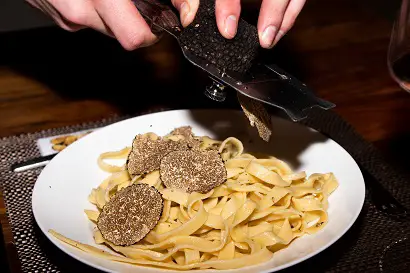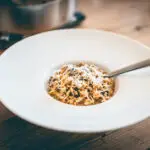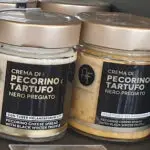Truffles have always had a bit of exotic imagery associated with them. Considered a high-class food, we imagine a truffle hunter with their pigs going out in the forest to fetch this delicacy at the break of dawn and fine meals made perfect with just a slight addition of these mushrooms. So, how do you eat truffles?

Traditionally truffles are eaten in moderation, either shaved into thin slices, such as white truffle on a baked potato for a ‘poor man’s truffle’, or finely grated winter black truffles served atop risotto, egg dishes, cheesy foods, and a number of other dishes that could use the unique truffle flavor that makes them so perfect.
Let’s take a closer look at the famous fungi popularized in Northern Italy since the Renaissance days. There’s a reason why truffles are so popular – if you know how to eat them, there is simply no other taste that quite compares!
Eating truffles the classic way – shaved
The delicious flavor of truffles is easy to incorporate into a number of dishes. For instance, burgundy truffles, sliced thin, simply laid atop dishes such as baked potatoes, and cheese dishes, or even mixed in small amounts with your favorite soup.
Risotto, especially, benefits from the earthy flavors of clean truffles, although burgundy and winter black truffles (Tuber Melanosporum) are an especially exquisite taste with a freshly-made risotto. Egg dishes, such as flan, omelets, or plain-old scrambled eggs also get a taste upgrade with the simple addition of this fabulous fungi. The same applies to truffle fondue.
You simply need to shave a truffle into long, thin slices and top your dish lightly, so as not to overwhelm its natural flavor. This adds accents to the taste that will make you want to take your time savoring the meal and THAT is the magic of truffles.
You don’t even have to get fancy — some shavings, sauteed lightly in unsalted butter and cooked with eggs add a taste of Northern Italy to otherwise humble breakfast fare.
Grated Truffle vs. Shaved
Some truffle fans prefer grated truffles to shaved ones, while others will actually use both methods to maximize both flavor and aroma. As such, it’s good to know the difference between grated truffles and shaved truffles in your dishes.
Grated truffles tend to create more of an aroma, as more of the truffle is introduced into the air. The tiny bits also add small, but sharp bursts of flavor, as well as a pleasant texture as you enjoy your truffle-enhanced dish.
Shaved truffles, by contrast, give you more of a balanced flavor with each bite. The bigger pieces are more pronounced on the palette and they also add a visual appeal to the dish so that both taste and presentation are addressed – an important part of any meal, as any chef will tell you.
Grated truffles are also a perfect fit for sauces. For instance, sautéing some grated black truffles with some diced shallots and garlic with unsalted butter and a dash of white wine can make for a sauce that really sings!
Sliced truffles, by contrast, don’t need a lot of fancy preparation to deliver. You could lay a number of winter black truffle slices atop a beef tenderloin, followed by a ladle of broth or cream gravy, and the taste medley of this simple combination is unforgettable.
White truffles work well for this too, so be sure to experiment — truffle flavor really ramps up any dish!
Black winter truffles are typically peeled and then eaten raw or you might enjoy them lightly cooked, whereas burgundy and white truffles should always be eaten raw – cooking might still get you that signature pungent aroma, but with white and burgundy truffles it will ruin the distinctive flavor – never cook them!
Can you eat truffles plain?
Yes, you don’t have to cook fresh truffles, clean truffles may be eaten raw, with the exception of preserved truffles. Preserved truffles, due to the sterilization process for adding them to a glass jar, tend to be dried out and are best enjoyed diced atop a hot dish of your choice.
Black winter truffles will typically need to be peeled, after which you may enjoy them raw or perhaps lightly cooked. Many truffle aficionados find that the perfect amount of heat is obtained by simply shaving the raw truffles at the edges of beef or another hot food item.
White truffles, simply sliced and eaten, are quite exquisite on their own or with a favorite cheese, while a burgundy truffle has an earthy taste of hazelnut when paired with food or eaten all on its own.
For the best flavor, however, pairings are recommended, and even something as simple as melted, unsalted butter and fresh truffles with white rice or the pasta of your choice is considered one of the best ways to enjoy them.
If you’re just getting to know the flavor, however, then we recommend trying them on their own and then adding a light dash of black pepper to see how it contrasts.
Taste is often a matter of simple pairings and trying out your fresh truffles with a few simple flavors can really help you to take your culinary fare to the next level.
We should note, to store fresh truffles you will want to clean and wrap each one individually in a paper towel, then place them inside an airtight glass or plastic container. Change out the paper towels every 24 hours and this will keep each fresh truffle in peak condition until you can enjoy them.
Preserving that fresh truffle flavor takes a little care, but trust us — it’s well worth it! If you can get them locally, we recommend starting with fresh black truffles for your tasting experiment.
There’s a reason truffles are so popular for pasta. If you only see the more common white truffles, however, then get those and use your handy truffle slicer or a sharp knife and try it plain on top of a baked potato.
Black or white truffle, you really can’t go wrong and before you know it, you’ll be adding truffle flavor to all kinds of dishes!
Truffle oil is another popular way to ingest them
Truffle oil is another way that many people like to eat their truffles and it’s quite easy to make. Truffle recipes don’t have to be complex.
For instance, a simple truffle oil may be made by heating up a pot to 125 degrees with a little vegetable oil and the truffle of your choice.
Once you let it cool, you’ll have a truffle-flavored oil that you can mix with pasta, dash in small amounts onto otherwise boring dry rice, or serve in a number of other creative ways.
You can also do the same truck with butter to make truffle butter and we highly recommend it. Truffle butter is a gift from the heavens!
You can store it away until you need it and it can make some of the simplest meals taste like expensive foods from high-end restaurants – it really packs a punch! If you try this, we recommend adding a little truffle oil to your favorite cheese sauce recipe. Don’t overdo it – just add a dash – and you’ll definitely notice the difference.
This is why truffle additions are so popular for egg pasta. If you’ve ever wondered why expensive foods such as your local favorite risotto really pop, it’s usually the truffle – there’s simply no other taste quite like it.
Some truffle fans even like to take the oil and use it to scramble eggs, butter, and cheese for truffle-flavored scrambled eggs that melt in your mouth!
Why is truffle oil controversial?
While truffle oil is amazing in cheese sauces, there’s a bit of controversy in eating them this way and we would be amiss not to mention this. With white, burgundy, and black truffles, a part of the experience is the texture and the subtle layers of flavoring that comes with it.
Truffle oil will definitely give your dishes that distinctive truffle aroma and some of the taste, but many argue that making it into an oil concentrates the flavors a bit too much.
This is something you will have to decide for yourself, of course, and the best way is going to be simply experimenting with your truffles.
Try fresh truffles raw and add them grated and sliced to cheese sauces. Try the recipe again with a light dash of your homemade truffle oil and see what you think.
Some classic combinations, such as truffle with Parmigiano Reggiano simply won’t work with oil — only fresh truffles –so a lot will depend on the types of dishes you are looking to enhance.
Fine dining is a very personal experience, so there really is no ‘wrong’ way to eat a truffle. If it delights your taste buds, then you’re doing it right. As oil, grated, or sliced, it makes any pasta primo, adds a nutty flavor to eggs, and brightens up any butter or cream sauce combo that you feel like whipping up.
Some final words on enjoying your truffles
We’ve talked about how to eat truffles and as you can see, you’ve got a lot of options at your disposal. Something as simple as scrambled eggs get an upgrade with that famous truffle flavor, and even just a little black or white truffle cooked in butter goes well in pasta, dry rice, or atop your favorite meats.
Don’t forget to never eat preserved truffles from a jar raw – these definitely need to be diced and added to hot foods for proper enjoyment and experiment a little with truffle oil. Despite the controversy, it’s all about finding the truffle flavor pairings that YOU like.
Burgundy, black, and white truffle pair with all kinds of things, so get some fresh truffles and store them properly with the instructions we’ve shared and go wild! An expensive dining experience doesn’t have to be limited to restaurants. With truffles at home, you’ll be able to enjoy that experience whenever you like!
- The Top Restaurants Specializing in Truffle Dishes - August 10, 2023
- Truffle Panna Cotta: A Decadent Dessert Recipe for Truffle Lovers - August 7, 2023
- Truffle Scrambled Eggs: A Luxurious Breakfast Delight - August 7, 2023








